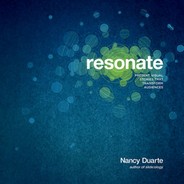
58 Resonate
One way to get to know your audience is through a process called segmenta-
tion. By partitioning a large audience into smaller subsegments, you can
target the segment that will bring the most additional supporters. Determine
which group is most likely to adopt your perspective—the group with which
you can make the greatest impact with the least effort. It’s tricky to appeal
to the broader audience and simultaneously connect deeply with the subset
that will play a key role in helping you—but it’s worth the effort.
The most commonly used segmentation method is to segment by demo-
graphics. Most conference organizers can provide only limited information
about the audience: where they work, their title, geographical location, and
company. You can make some assumptions from this information, but it’s
limited to just that—assumptions.
When I presented to top executives from a national beer manufacturer, I
needed to spend time thinking about how to connect with them, because
based on demographics alone, we did not have much in common in this arena.
I’m a middle-aged female who drinks fruity cocktails because I imagine beer
might taste like fizzy pee. That’s a pretty big gap.
I didn’t receive enough information from the event organizers to feel like I
really knew what’s important to them.
Segment the Audience
BEER EXECUTIVES NANCY DUARTE
Gender 34 Males, 14 Females Female
Job Title Executives with titles like
director, vice president,
and CMO
Entrepreneur and CEO
Geography They flew in from 11 countries I drove 3.6 miles up the road
CH003.indd 58CH003.indd 58 8/16/10 4:02:13 PM8/16/10 4:02:13 PM

Get to Know the Hero 59
Collecting their gender and country of origin isn’t enough
information to communicate with them meaningfully.
Audiences aren’t moved solely because they are old or
young, from Kansas or from California. Their demograph-
ics are only part of the story.
Truly communicating effectively takes research. That can
mean sending out your own survey that will help you gain
insights or—if you’re targeting a broader industry group—
going online and finding popular blogs by industry icons
to see what’s on their minds. You might take note of what
they chat about on social media sites until you reach a
point where you feel you know them personally.
Don’t segment the audience in a clichéd or generalized
way. Defining your audience too broadly can make you
seem impersonal or unprepared. It can cause your audi-
ence to feel like a statistic, or like they are being narrowly
stereotyped, which can be offensive. The main idea is
that you need to define the audience in a way that’s
accurate and appropriate for the kind of presentation
you will deliver.
Several things helped me prepare for the presentation to
the beer executives. I bought subscriptions to a couple
of key marketing publications to see what was being said
about their brands, solicited feedback from my social
network, searched for articles about them, reviewed the
conversations in the top beer blogs, found their own
presentations on the Web, read their press releases, and
read their company’s latest annual report.
The research helped me understand their challenges.
Even though I only used a portion of the insights in the
actual presentation, I felt like I knew them and had empa-
thy for what was on their minds. Those insights helped
me feel connected to them.
CH003.indd 59CH003.indd 59 8/16/10 4:02:13 PM8/16/10 4:02:13 PM
..................Content has been hidden....................
You can't read the all page of ebook, please click here login for view all page.
